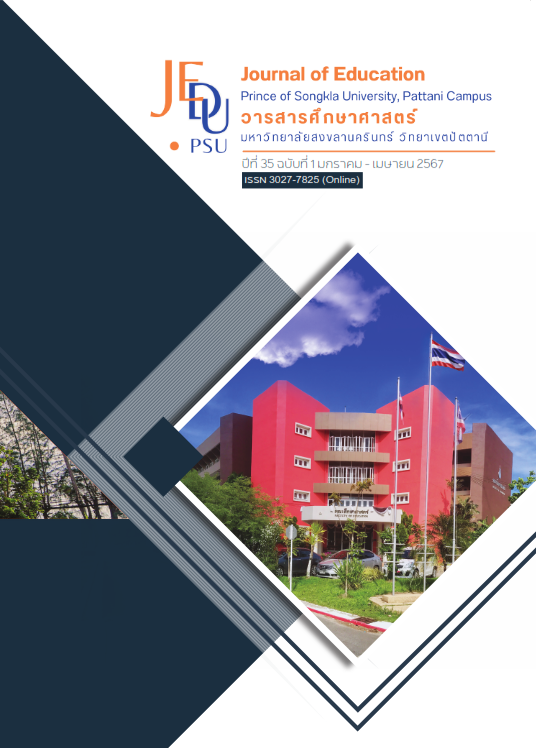The Development of Biological Literacy Examination for High School Students in the Three Southernmost Provinces
Main Article Content
Abstract
The objectives of this research were to develop biological literacy tests, validate the parallelism of the test and construction of biological literacy norms for high school students. The population was 1,353 large school students in the three southernmost provinces in Mathayomsuksa 6. The sample consisted of 290 people using Krejcie & Morgan (1970) to estimate the appropriate sample size and the quota sampling technique was used for sample selection. The data were statistically analyzed to derive basic statistics, validate the parallelism of the test, one – way ANOVA and construction norms of biological literacy. The results showed both biological literacy tests that were constructed had quality according to the specified criteria and the tests were parallel to each other. The overall average score of the 1st and 2nd tests was 24.06 and 24.24 points out of 40 points, respectively. When considered each aspect separately, it was found that the 1st test of knowledge, context and attitude had an average of 15.19, 6.01 and 2.81 points and the 2nd test of knowledge, context and attitude had an average of 15.08, 6.03 and 3.13 points out of 24, 11 and 5 points, respectively. The average
biological literacy scores classified by schools overall had no statistically significant difference overall. For the norms of biological literacy scores of the sample, there were T scores ranging from T27 to T72 (P0.52 – P99.48). The developed norms were based on norm-referenced evaluation of high school students in large schools in the three southernmost provinces.
Article Details

This work is licensed under a Creative Commons Attribution-NonCommercial 4.0 International License.
References
Anne, L. & Helin, S. (2021). Exploring Biological Literacy: A Systematic Literature Review of Biological Literacy. European Journal of Educational Research, 10(3), 1181-1197.
Arlee, N. (2016). Effect of 4 MAT Instruction on Learning Achievement, Retention and Instructional Satisfaction of Grade 12 Students. [Master’s thesis, Prince of Songkla University]. PSU Knowledge Bank. [in Thai]
Arzu, O., & Sule, F. D. (2019). Identifying the Predictive Power of Biological Literacy and AttitudesToward Biology in Academic Achievement in High School Students. International Online Journal of Educational Sciences, 11(2), 214-228.
Bansomdejchaopraya Rajabhat University. (2020). Importance of biology. http://site.bsru.ac.th/bio/?page_id=136 [in Thai]
Buasri, P. (2017). Constructing a Test of Integrated Science Process Skills for Grade 9 Students. [Master’s Thesis, Rajabhat Maha Sarakham University]. SNRU e-thesis. [in Thai]
Clark-Carter, D. (2005). Percentiles. In Everitt, B. S. & Howell, D. C. (eds.), Encyclopedia of Statistics in Behavioral Science. Chichester, Wiley & Sons.
Fahrungsang, B. (2007). The research administrative in education policy of the government in southern border provinces (1977 - 2007) (Research report). Prince of Songkla University, Pattani Campus. [in Thai]
Kanchanapenkul, S. (2011). A Construction of Parallel Domain-referenced Test on “Circles” by using Facet Design for Matthayomsuksa 3. [Master’s thesis, Srinakharinwirot University]. The central library of Srinakharinwirot University. [in Thai]
Krejcie, R. V., & Morgan, D. W. (1970). Determining sample size for research activities. Educational and Psychological Measurement, 30(3), 607–610.
Lynn, M. R. (1986). Determination and quantification of content validity. Nursing Research, 35, 382-385.
Mahama, A., Lateh, A., & Waewthongrak, W. (2021). A Comparative Study and Construction of Scientific Literacy Norms of Teacher Professional Students in Three Southernmost Provinces. Journal of Yala Rajabhat University, 16(3), 287-296. [in Thai]
Office of the Permanent Secretary, Ministry of Education. (2020). National o-net test results, Mathayomsuksa 6 level. https://sp.moe.go.th/sp_2563/info. [in Thai]
Organization for Economic Co-operation and Development. (2016). PISA 2015 Results (Volume I): Excellence and Equity in Education. OECD Publishing.
Paisanit, P. (2013). Research and development of research strategies to improve scientific literacy of ninth grade students. [Master’s Thesis, Department of Educational Research Methodology]. Chulalongkorn University. [in Thai]
PISA Thailand. (2017). PISA 2015 Student Evaluation Framework. https://library.ipst.ac.th/bitstream/handle/ipst/5534/32.PISA-2015Framwrok.pdf?sequence=1&isAllowed=y [in Thai]
Ritcharoon, P. (2001). Principles of Measurement and Evaluation. (3rd ed.) Phranakhon Rajabhat University.
Rodpan, K. & Lawthong, N. (2022). Development of three-tier parallel diagnostic test based on misconceptions in science for lower secondary school students. Journal of Educational Measurement, 39(105),1-13. [in Thai]
Saiyos, L., & Saiyos, A. (2000). Techniques for measuring learning outcomes. Suriwiyasas. [in Thai]
Secondary School Performance Standards. (2009). School Performance Standards. http://www.thaischool.in.th/_files_school/27100420/data/27100420_1_20200922-173828.pdf
Semilarski, H., & Laius, A. (2021). Exploring Biological Literacy: A Systematic Literature Review of Biological Literacy, European Journal of Educational Research, 10(3), 1181-1197. https://doi.org/10.12973/eu-jer.10.3.1181
Sueri,N., Lateh, A., & Waewthongrak, W. (2023). A Comparative Study and Development of Norm Biological Literacy of Students of Princess Chulabhorn Science High Schools in Thailand. Humanities and Social Sciences Journal of Pibulsongkram Rajabhat University, 17(2). [in Thai]
Suwono, H., Pratiwi, H., E., Susanto, H., & Susilo, H. (2017). Enhancement of Students’ Biological Literacy and Critical thinking of Biology Through Socio-Biological Case-Based Learning. Pendidikan IPA Indonesia, 6(2),213-220.
Tangpraprutgul, P. (2015). What is biology. https://www.youtube.com/watch?v=VEg_OuuI-F4 [in Thai]
The institute for the Promotion of Teaching Science and Technology. (2017). PISA 2015 Student Assessment Framework. The institute for the Promotion of Teaching Science and Technology. [in Thai]
Thomson, S., Hillman, K., & Bortoli, L.D. (2013). A teacher’s guide to PISA scientific literacy. Victoria, ACER Press.
Uno, G.E., & Bybee, R.W. (1994). Understanding the dimensions of biological literacy. BioScience, 44(8), 553-557.


